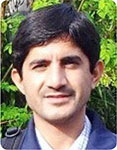Challenges in hydraulic fracturing from perforated boreholes in unconventional reservoirs
Seyed Hassan Fallahzadeh Abarghooei A and Vamegh Rasouli ACurtin University
The APPEA Journal 54(1) 285-294 https://doi.org/10.1071/AJ13028
Published: 2014
Abstract
In recent years, with the evolution of unconventional reservoirs, hydraulic fracturing has been applied to tight sandstone and shale formations to improve the hydrocarbon production. The application of hydraulic fracturing in cased boreholes is always associated with many difficulties because the fracture has to be initiated from the perforations. There have been many cases of improper fracture initiation in tight formations, which have then resulted in premature screen out, and have not improved reservoir production.
In this study, initiation of hydraulic fracturing from a perforated tunnel was studied numerically using a finite element method. The numerical model was generated to represent a laboratory experimental test, which has been carried out on tight concrete cubic samples. A perforated wellbore in a linearly elastic tight formation was modelled using Abaqus software through three-dimensional numerical analysis. Two different perforation orientations were considered to analyse the fracture initiation pressure (FIP) and the location and initial direction of the crack. Different far field stresses were considered to study the effect of in-situ stresses and perforation directions on the fracture initiation mechanism. The results were then compared to laboratory and analytical outcomes, and good agreement was observed. The results provide a better understanding on how the stress regime, stress anisotropy, and perforation orientation could affect the pressure and geometry of fracture initiation in tight formations. Based on the outcomes of this study, better strategies can be decided for perforating a cased wellbore in a tight formation so that lower FIP is experienced and a better near wellbore fracture is created.

Seyed Hassan Fallahzadeh is a PhD student at the Petroleum Engineering Department of Curtin University. His research focuses on hydraulic fracturing in perforated boreholes. The main objectives of his study are to analyse the mechanisms of fracture initiation and near wellbore propagation in a cased perforated wellbore. Seyed has also been involved in some other Petroleum Geomechanics projects with the Curtin Petroleum Geomechanics Group (CPGG). Seyed has received his BSc (2007) and MSc (2010) in Petroleum Engineering from Petroleum University of Technology. He was also awarded a master degree in petroleum well engineering from Curtin University, Perth in 2009. s.hasan.fallah@gmail.com |

Vamegh Rasouli is an associate professor and head of department of Petroleum Engineering at Curtin University in WA. He is a Chartered Professional Engineer (CPEng) and is a registered engineer with the National Professional Engineers Register (NPER) of Australia. Vamegh received his PhD from Imperial College London in 2002. In 2006, after joining Curtin University, he established the Curtin Petroleum Geomechanics Group (CPGG) and the Curtin Drilling Research Group (CDRG) in 2010. Vamegh is supervising a number of PhD students and is involved in a number of research and consulting projects in the area of geomechanics and drilling. He has done several projects related to petroleum geomechanics for various companies and has also been a consulting engineer on various geomechanics related projects with Schlumberger’s Data and Consulting Services (DCS) in Perth. v.rasouli@curtin.edu.au |


